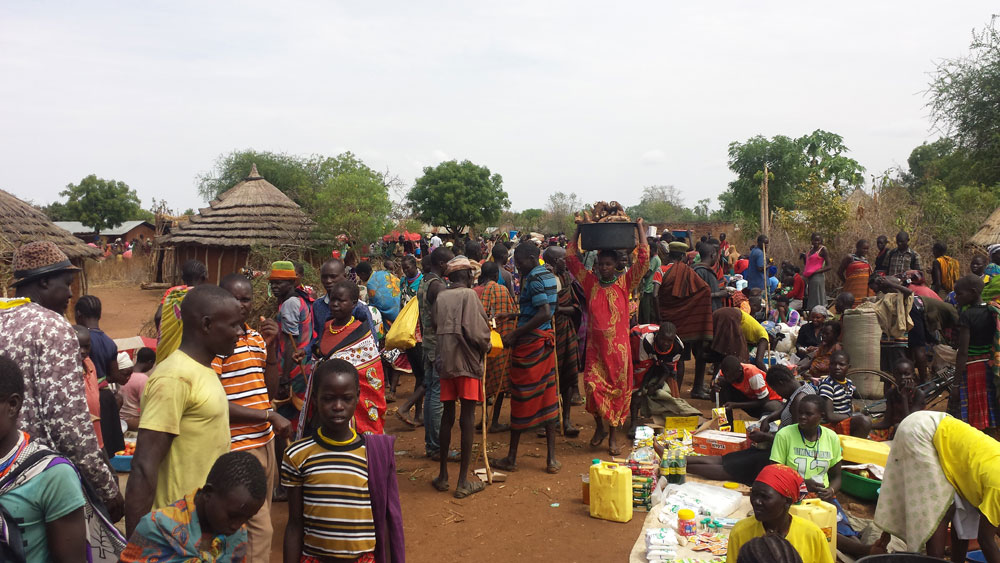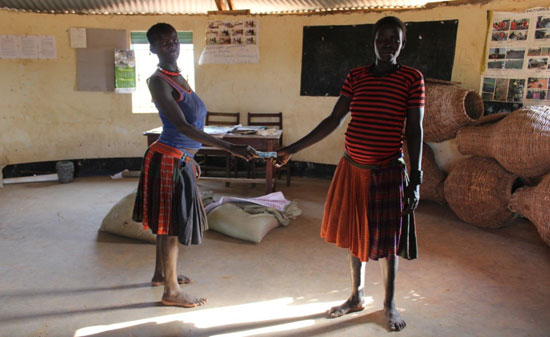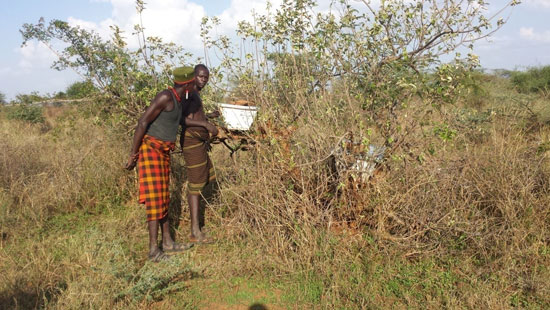Think Globally, Act Locally: Building Rural Climate Resilience in Karamoja, Uganda

Table of Contents
- Karamoja: What is at stake?
- ECO Uganda and climate proof eco-smart Disaster Risk Reduction in Karamoja
- Conclusions
Across our planet, anthropogenic climate change is manifesting itself through the spearheading symptom of global warming that is driving other ensuing symptoms such as ocean acidification, sea level rise, loss of ice sheets, retreat of glaciers and snow covers, and climate-driven extremes such as droughts, floods and tropical cyclones. These symptoms in the climate system have enormous adverse impacts and pose risks and challenges on human systems (settlements, livelihoods, public health and safety, economy and society) interfering with the socio-economic development processes as well. As a response, the global community aspires to common yet customized action against climate change according to the specific geographical, social, economic, educational, and infrastructural conditions through establishing and strengthening the ability of systems and communities to resist, absorb, accommodate, adapt to, transform and recover from the hazardous effects of climate change in a timely and efficient manner, in short climate resilience.
The concept of climate resilience holds specific importance in the poorest and vulnerable contexts where high exposure to adverse impacts and lack of capacity exist, which requires immediate adaptation and disaster response strategies before a climate hazard evolves into a disaster and severely interferes with the normal functioning of a community and of development path.
Today, this article will take you to a journey in sub-Saharan Africa, in order to briefly illustrate how the global climate crisis translates into a local reality in one of the poorest and most vulnerable regions in the world: Karamoja, Uganda.
Karamoja: What is at stake?
Karamoja is a region located in the north-east of Uganda, neighboring with Kenya and South Sudan, and inhabits an estimated 1.4 million people. The region has always been an area of particular importance and attention for the humanitarian and development organizations, since Karamoja is classified as the poorest and least developed region in Uganda, based on the poverty rates and human development indexes. Considering the fact that Uganda is classified as a least developed country and ranked 165 among 189 countries in terms of GDP per capita adjusted for purchasing power parity by World Economic Outlook Database 2016 of International Monetary Fund (IMF), Karamoja, therefore, represents the poorest of the poor.
When it comes to climate risk and resilience analysis, Karamoja exhibits one of the highest levels of vulnerability and least levels of adaptive and responsive capacity around the world. Along with economic poverty, the non-economic dimensions of poverty as non-climate stressors –such as poor physical infrastructure, unfavorable trajectories on education and health spheres and inadequate availability of basic needs like food and water- add to low climate resilience level of Karamoja.
In order to fully comprehend the conditions and life in the region, it is important to take a glance at the dynamics of geographic, climatic and socio-economic features. To begin with the geographic and climatic characteristics, Karamoja is set on a large plateau surrounded by mountains and much of Karamoja is more than 1,000 meters above sea level. The land cover is mainly composed of arid and semi-arid savannah, bush lands, thorny plants, seasonal grasslands, and occasional small trees. Karamoja does not have a significant water body as well, and the water resources are limited to few perennial mountain streams, springs and wells that run off through the seasonal riverbeds. In connection to this, Karamoja has a mono-modal rainfall pattern with the commencement of rainfall at the end of March and the cessation in October with a short periodic laxity of rain in June, and consequently, there lays a prolonged dry period from November to March.
As regards the socio-economic structure in the region, the Karamojong (the name “Karamojong” in this work is utilized to refer to the people of Karamoja and does not indicate a specific ethnic group) has traditionally been a nomadic, warrior and pastoralist society; however, the state intervention programs to the armament and militancy in the region since 2002, and the government development plans for Karamoja based on the transition to settlement have jointly changed the socio-economic dynamics in the region. Today, the Karamojong people lead a sedentary life, and therefore, in terms of economic activities, the main sources of livelihood in the region are agriculture and pastoralism along with the mining activities on gold and various other minerals. The livestock production and pastoralism -including cattle, goat, sheep and camels- is at the heart of the economic activities in Karamoja and the cattle is considered to be the most valuable means of livelihood in the region. Indeed, as the saying goes, “the Karamojong live and die for cattle". In most of the cases, the livestock rearing is combined with subsistence agriculture practices, to complement the household livelihoods; therefore, agro-pastoralism is the most dominant livelihood strategy of the Karamojong people. Therefore, agricultural production in Karamoja is strictly rain-fed, and the principle cultivation crops are sorghum, maize, cassava, beans, cow-peas, groundnuts, sunflower, simsim (the word for sesame in the local language) and sweet potatoes.
Bearing in mind the geographic, climatic and socio-economic features of the region coupled with high poverty levels, during the field research that I in Nakapiripirit District in March 2018 (The manifestations of the climate change in the region are compiled from the focus group discussions held in three different villages: Napayan, Nathinyonoit and Namidikao), it has been comprehended that that climate change manifests itself in the region and district in the form of:
- Increasing average temperatures and sunlight exposure
- Prolonged dry spells (and droughts every two or three years)
- Increasing intensity of rainfall in the rainy season (therefore floods)
- Increasing unpredictability of weather and climate casts
- Erratic rainfall distribution and duration
These manifestations have various economic (agricultural and pastoral), food-related, health-related, water-related and environmental implications for the area. These manifestations have various economic (agricultural and pastoral), food-related, health-related, water-related and environmental implications for the area. To begin with, the prolonged dry season and sunlight result in failures in the cultivation of crops and vegetables coupled with the water stress for agriculture. In the wake of rainy season, the erratic rainfall patterns (too early or too late rainfall) may also interfere with the natural growth process of the crops. During the rainy season, the heavy rainfall that turns into floods washes out the plantations, which yields almost zero harvest. In return, these cultivation failures lead to periodic hunger and famines in the villages, threatening the food security that is already fragile in the region. Moreover, the warming of the temperatures and increasing intensity of rainfalls affect the livestock as a result of lack of grass and water to sustain the animals and spread of diseases among the animals in warm and wet periods. The loss or damages on crop harvest and livestock therefore strike a major blow on the livelihoods of the Karamojong people, influencing their already scarce incomes. Furthermore, certain diseases and human epidemics become more common in the region combined with the poor infrastructure, sanitation and health services. In the dry season, the respiratory distress spread among the adults and elderly. On the other hand, the rainy season peaks the prevalence of water-borne and vector-borne diseases -such as malaria, typhoid and cholera- as a result of floods that enhance the water contamination. The fact that the sanitation facilities such as pit latrines, drying racks or bathing shelters are not common and the lack of effective waste disposal jointly contribute to the contamination and spread of these diseases. Besides, the dry season enhances the water stress in the region, further affecting the water availability given that the water resources are already scarce. The inadequate water supply infrastructure -such as limited number of boreholes and pipes and lack of deep well pumps- makes it difficult for the utilization of the deeper underground water resources in the dry periods. In the rainy season, the water contamination threatens the quality of water available for drinking, irrigation and personal hygiene and leads to water-borne or food-borne diseases. Lastly, while high temperatures and water stress dry out the planted trees and grassland, the heavy rainfall contributes to soil erosion, which reflects on the environmental implications of climate change.
The traditional response strategies of local communities for the adverse impacts of climate change have shown to be economically and environmentally not sustainable due to the intensification and increasing frequency of climate extremes. Therefore, the urgent need for root-cause-oriented adaptive and coping strategies for resilience building has come to the fore.
ECO Uganda and climate proof eco-smart Disaster Risk Reduction in Karamoja
In order to build more sustainable and resilient communities to cope with climate change and its impacts, a local NGO –Ecological Christian Organization (ECO) Uganda- has launched its community-based project Climate Proof and Eco-Smart Disaster Risk Reduction with 8 interventions in 25 villages Nakapiripirit and Napak Districts in the region, where each intervention touches upon environmental, social and economic spheres. We will now briefly cover these interventions.
Village Savings and Loan Associations (VSLAs) are designed and introduced to provide an immediate access to basic financial services such as savings and credits for the villagers in case of needs related to loss of livelihoods and crop failures and to enhance the access to education and health facilities by financial means.
Climate Information Centers with Disaster Risk Reduction Committees are established in order to strengthen early warning systems for extreme climate and weather events through climate information dissemination (both indigenous and scientific information) and capacity development; so that the effective and timely adaptive and responsive measures can be taken accordingly. The Centers and their committees particularly work on the correct prediction of rainfall patterns or dry spells so that the villagers can clear their gardens, plant their crops and harvest them timely.

A debt pay-off between the VSLA members at the Climate Information Center in Namidikao Village
Small Kitchen Gardens are introduced in the districts in order to help the communities to maintain the availability and variety of fresh greens and vegetables mainly for the household consumption during the dry spells, to cope with malnutrition and food security. The gardens also create additional income for the villagers in cases of good yields since the extra products are sold in the markets.
Apiary (Bee-keeping) is promoted as an alternative livelihood activity and in the introduction phase the bee hives are provided by ECO Uganda to the villagers. Apiary is found to be economically, socially and environmentally sustainable for the community resilience: good harvests provide the owners with enough honey both for home consumption and market sales that create additional income, and the bee owners are found to be more prone to preserve the environment, plant trees and keep it green.

Two beekeepers with their bee hives in Namidikao Village
Environmental Conservation and Tree Planting interventions are carried out by Climate Information Centers and Disaster Risk Reduction Committees. These include awareness raising activities such as trainings on the destructive effects of stubble burning, erroneous firewood collection, and tree-cutting on the environment and livelihoods. The tree-planting pillar focuses on the re-plantation of already-existing tree species in the area and the introduction of new fruit trees and their maintenance, in order to both keep the area green and provide fruits for the consumption by the villagers. The trees also reduce the soil erosion and damages of floods in the villages during the rainy season.
Drought-resilient Seeds and Practices are introduced by ECO Uganda in the agricultural and agro-forestry activities during the dry spells through the trainings on drought tolerant farming practices, proper agronomics and post-harvest practices such as indicators of good soil, qualities of seeds, mixed cropping, and crop diversification.
Energy-saving Stoves are promoted in the villages by ECO Uganda and they provide trainings on the process of stove construction and maintenance because they are easy to make, requires less firewood, portable to take inside places in case of rains, and safer to use. Moreover, the constructed stoves are also sold in the markets, providing additional income to the villagers, and the less firewood requirement contributes to the environmental preservation.
Lastly, Hygiene and Sanitation activities are introduced by ECO Uganda to foster community health resilience with the sensitization of the communities on the personal hygiene and sanitation through the trainings on the construction and utilization of the sanitary components, especially of pit latrines, drying racks, rubbish pits, bathing shelters and their maintenance. The usage of components is aimed to prevent the water contamination and spread of diseases such as typhoid, cholera, diarrhea and malaria especially during the rainy season.
During the field work conducted in March 2018 in the ECO Uganda treatment villages, it has been observed that the interventions overall yield positive environmental, social and economic impacts and show improvements towards the resilience of the communities. It is also essential to bear in mind that, systemic, infrastructural and geo-climatic conditions in each village and their externalities can play an immense role in the achievement of successful outcomes for these ECO interventions, therefore we recognize the risks and challenges they may pose as inhibitors in the path for sustainable climate resilience.
Conclusions
Climate change is happening for real at an unprecedented scale across the globe in different forms through the symptoms and signs of our planet. While being a global problem, the immediate adverse impacts of climate change are mostly felt in the local level and the consequences are borne by the local populations. The level of interference of climate change on human systems is found to be highest for the poorest and most vulnerable communities around the world where the factors of chronic poverty and inadequate infrastructure are prevalent; which intensifies the experienced adverse impacts as well as lowers the responsive and adaptive capacity.
The case of Karamoja and ECO Uganda’s work show us that how the local organizations and local communities can go hand in hand and successfully cooperate to scale up sustainable community resilience against climate change risks in the region, while translating the global into local and presenting a good multilevel governance case for the greater aspirations of global community.

